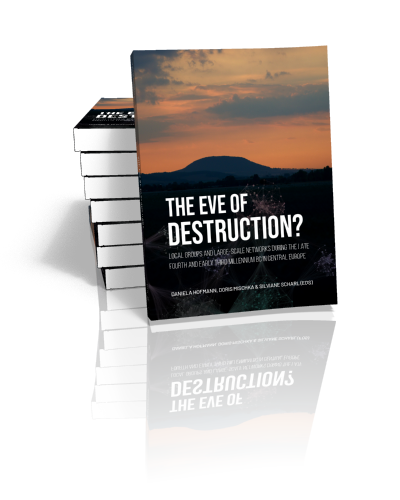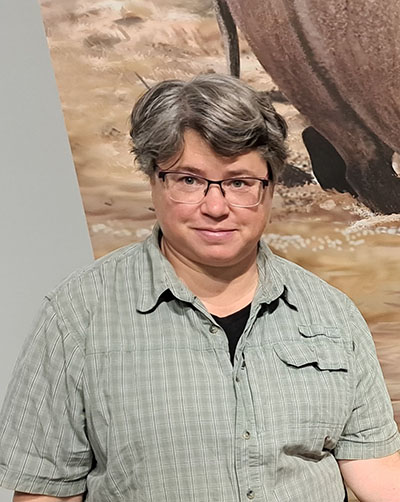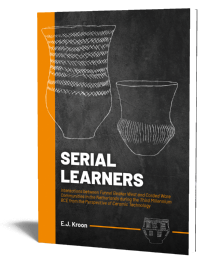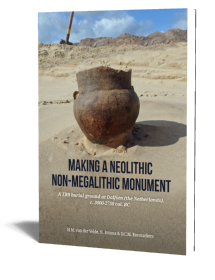The eve of destruction?
Local groups and large-scale networks during the late fourth and early third millennium BC in central Europe
Edited by Daniela Hofmann, Doris Mischka & Silviane Scharl | 2025

The eve of destruction?
Local groups and large-scale networks during the late fourth and early third millennium BC in central Europe
Edited by Daniela Hofmann, Doris Mischka & Silviane Scharl | 2025
Paperback ISBN: 9789464263114 | Hardback ISBN: 9789464263121 | Imprint: Sidestone Press | Format: 210x280mm | 324 pp. | Language: English | 35 illus. (bw) | 131 illus. (fc) | Keywords: prehistoric archaeology; funerary archaeology; Central Europe; Late Neolithic; pre-Corded Ware; change; continuity; transition | download cover | DOI: 10.59641/qq545tc | CC-license: CC BY-NC-ND 4.0
Read online or downloaded 880 times
-
Digital & Online access
This is a full Open Access publication, click below to buy in print, browse, or download for free.
-
Buy via Sidestone (EU & UK)
-
Buy via our Distributors (WORLD)
For non-EU or UK destinations you can buy our books via our international distributors. Although prices may vary this will ensure speedy delivery and reduction in shipping costs or import tax. But you can also order with us directly via the module above.
UK international distributor
USA international distributor
-
Bookinfo
Paperback ISBN: 9789464263114 | Hardback ISBN: 9789464263121 | Imprint: Sidestone Press | Format: 210x280mm | 324 pp. | Language: English | 35 illus. (bw) | 131 illus. (fc) | Keywords: prehistoric archaeology; funerary archaeology; Central Europe; Late Neolithic; pre-Corded Ware; change; continuity; transition | download cover | DOI: 10.59641/qq545tc | CC-license: CC BY-NC-ND 4.0
Read online or downloaded 880 times

We will plant a tree for each order containing a paperback or hardback book via OneTreePlanted.org.
This volume collects papers on the pre-Corded Ware horizon in central Europe and adjacent areas (i.e. from c. 3500 – 2800 BC). This phase is very patchily researched, partly also because certain kinds of evidence, notably domestic architecture and burials, are rare or absent in many regions. This has occasionally been interpreted as signs of a major crisis and population bottleneck, which in turn facilitated the migration of new populations from the steppe, bringing with them amongst others new economic regimes, ideologies and settlement patterns.
Research over the last few years has shown that this scenario needs to be nuanced. Although evidence remains scattered, a picture of regional diversity is emerging, with probably mobile but well-connected Late Neolithic societies undergoing social changes of their own, and instituting several key innovations long before the appearance of the Corded Ware. This volume offers a selection of such case studies, comprising amongst others an overview over the steppe background of new mortuary practices, contributions on settlement and changing networks in Switzerland, Poland and several regions of Germany, as well as discussions on the spread of pottery innovations and lithic material, the possible effect of droughts on Late Neolithic societies, new patterns of monumentality and figurative expression, the social role of battle axes, networks of influences visible in burial rites, and the possibility for “parallel societies” with different modes of life. An introductory chapter draws out central themes.
Together, these contributions show that the transition to the Corded Ware culture was a diverse and multi-facetted process, with many continuities across the transition.
The pre-Corded Ware horizon in central Europe and why it matters – an introduction to the volume
Daniela Hofmann, Doris Mischka and Silviane Scharl
The times they are a-changin’. The Final Copper Age between the eastern Carpathians and the Don river
Elke Kaiser
The arrival of the Corded Ware in eastern Switzerland. A settlement archaeological view
Niels Bleicher
Pots without plots? Danubian and other non-local finds in Horgen cultural contexts of the thirty-second century BC and beyond at Lake Constance and in Upper Swabia
Joachim Köninger
The time of the cord rollers. Textile-roughened pottery of the early third millennium BC and cultural transmission networks from a south-western German perspective
Philipp Gleich
Decades of drought in the twenty-eighth century BC and its effects on settlement and culture
Joachim Pechtl and Alexander Land
In the middle of nowhere – Burgerroth and the Early Final Neolithic in Franconia
Thomas Link
Networks at the turn of the millennium — the situation in northern Bavaria
Martin Nadler
Long barrows, causewayed enclosures and the long term spiritual continuity in ritual landscape around Mount Říp in Bohemia (Czech Republic)
Jan Turek, Petr Krištuf and Ondřej Švejcar
The third millennium BC in the German lower mountain ranges: Are social ties falling apart?
Clara Drummer
Lithics, Lousberg axes and no settlements. In search of the late fourth millennium BC in the Lower Rhine area
Silviane Scharl and Ingrid Koch
In varietate concordia — united in diversity. Battle axes, coarse ware pottery and burial rituals during the Late Neolithic of western and central Europe and their meaning for the deconstruction of Final Neolithic narratives
Sebastian Schultrich
Continuation and change in settlement of the Polish Lowland in the period 3300–2700 BC
Marzena Szmyt
Societal rise, dissolution and diversity: from Funnel Beaker (TRB) societies to Single Grave groups on the North European Plain (c. 3300–2700 BC)
Jan Piet Brozio
Global transformation? Globular Amphora sedentary pastoralists 3200–2700 BC
Johannes Müller
Parallel societies: evidence for the co-existence of Late Funnel Beaker West and Early Corded Ware communities
Quentin P.J. Bourgeois, Erik J. Kroon and S. Louise Olerud
Same old, same old? Fisher-hunter-gatherer graves, burials and mortuary practices in the late fourth and early third millennium BC northern and eastern Baltic Sea region
Marja Ahola

Prof. Dr. Daniela Hofmann
Daniela Hofmann is Professor of Archaeology at Bergen University, where she teaches and researches mainly on the Neolithic of Europe. Her current interests include migration, kinship, ritual, social inequality and resistance to it, as well as social contacts and change (see the forthcoming co-authored volume Negotiating migrations. The archaeology and politics of mobility, 2024, and the co-edited outreach publication Migration narratives in archaeology, 2023). In her projects, she tries to combine theoretical considerations with a variety of methods, including bioarchaeological information, in an effort to write narratives that take into account different perspectives. She hopes that knowing about diversity in the past could help us create a fairer society today, but has doubts on whether this is actually working.

Prof. dr. Doris Mischka
Doris Mischka is Professor for Prehistoric Archaeology at the Friedrich-Alexander Universität Erlangen-Nürnberg. Previously, she worked at the Universities of Göttingen, Kiel, Bologna and Cologne. Her publications are devoted mainly to the Linear Pottery culture, the Funnel Beaker culture and Cucuteni-Tripyllia. She is also interested in landscape archaeology and has worked on lithics and pottery. Her most recent publications include an exhaustive study of the Neolithic burials in Flintbek (Das Neolithikum in Flintbek, Kr. Rendsburg-Eckernförde, Schleswig-Holstein. Eine feinchronologische Studie zur Besiedlungsgeschichte anhand von Gräbern, 2022), and co-editorship of a landmark introductory work on the Neolithic of Bavaria (Steinzeit in Bayern. Das Handbuch in 2 Bänden, 2023, with T. Uthmeier). Currently she conducts fieldwork in Romania.

Prof. dr. Silviane Scharl
Silviane Scharl is Professor for Prehistoric Archaeology at the University of Cologne. One focus of her research is on the central European Neolithic, where she has published extensively on networks of innovation and on human mobility (see e.g. Human mobility and the spread of innovations – case studies from Neolithic Central and Southeast Europe. Open Archaeology 9/1, 2023). She has also written an introductory volume on the Neolithic in central Europe (Jungsteinzeit – Wie die Menschen sesshaft wurden, 2021). In her current project, she explores the Late Neolithic in the Rhineland in western Germany.
Abstract:
This volume collects papers on the pre-Corded Ware horizon in central Europe and adjacent areas (i.e. from c. 3500 – 2800 BC). This phase is very patchily researched, partly also because certain kinds of evidence, notably domestic architecture and burials, are rare or absent in many regions. This has occasionally been interpreted as signs of a major crisis and population bottleneck, which in turn facilitated the migration of new populations from the steppe, bringing with them amongst others new economic regimes, ideologies and settlement patterns.
Research over the last few years has shown that this scenario needs to be nuanced. Although evidence remains scattered, a picture of regional diversity is emerging, with probably mobile but well-connected Late Neolithic societies undergoing social changes of their own, and instituting several key innovations long before the appearance of the Corded Ware. This volume offers a selection of such case studies, comprising amongst others an overview over the steppe background of new mortuary practices, contributions on settlement and changing networks in Switzerland, Poland and several regions of Germany, as well as discussions on the spread of pottery innovations and lithic material, the possible effect of droughts on Late Neolithic societies, new patterns of monumentality and figurative expression, the social role of battle axes, networks of influences visible in burial rites, and the possibility for “parallel societies” with different modes of life. An introductory chapter draws out central themes.
Together, these contributions show that the transition to the Corded Ware culture was a diverse and multi-facetted process, with many continuities across the transition.
Contents
The pre-Corded Ware horizon in central Europe and why it matters – an introduction to the volume
Daniela Hofmann, Doris Mischka and Silviane Scharl
The times they are a-changin’. The Final Copper Age between the eastern Carpathians and the Don river
Elke Kaiser
The arrival of the Corded Ware in eastern Switzerland. A settlement archaeological view
Niels Bleicher
Pots without plots? Danubian and other non-local finds in Horgen cultural contexts of the thirty-second century BC and beyond at Lake Constance and in Upper Swabia
Joachim Köninger
The time of the cord rollers. Textile-roughened pottery of the early third millennium BC and cultural transmission networks from a south-western German perspective
Philipp Gleich
Decades of drought in the twenty-eighth century BC and its effects on settlement and culture
Joachim Pechtl and Alexander Land
In the middle of nowhere – Burgerroth and the Early Final Neolithic in Franconia
Thomas Link
Networks at the turn of the millennium — the situation in northern Bavaria
Martin Nadler
Long barrows, causewayed enclosures and the long term spiritual continuity in ritual landscape around Mount Říp in Bohemia (Czech Republic)
Jan Turek, Petr Krištuf and Ondřej Švejcar
The third millennium BC in the German lower mountain ranges: Are social ties falling apart?
Clara Drummer
Lithics, Lousberg axes and no settlements. In search of the late fourth millennium BC in the Lower Rhine area
Silviane Scharl and Ingrid Koch
In varietate concordia — united in diversity. Battle axes, coarse ware pottery and burial rituals during the Late Neolithic of western and central Europe and their meaning for the deconstruction of Final Neolithic narratives
Sebastian Schultrich
Continuation and change in settlement of the Polish Lowland in the period 3300–2700 BC
Marzena Szmyt
Societal rise, dissolution and diversity: from Funnel Beaker (TRB) societies to Single Grave groups on the North European Plain (c. 3300–2700 BC)
Jan Piet Brozio
Global transformation? Globular Amphora sedentary pastoralists 3200–2700 BC
Johannes Müller
Parallel societies: evidence for the co-existence of Late Funnel Beaker West and Early Corded Ware communities
Quentin P.J. Bourgeois, Erik J. Kroon and S. Louise Olerud
Same old, same old? Fisher-hunter-gatherer graves, burials and mortuary practices in the late fourth and early third millennium BC northern and eastern Baltic Sea region
Marja Ahola

Prof. Dr. Daniela Hofmann
Daniela Hofmann is Professor of Archaeology at Bergen University, where she teaches and researches mainly on the Neolithic of Europe. Her current interests include migration, kinship, ritual, social inequality and resistance to it, as well as social contacts and change (see the forthcoming co-authored volume Negotiating migrations. The archaeology and politics of mobility, 2024, and the co-edited outreach publication Migration narratives in archaeology, 2023). In her projects, she tries to combine theoretical considerations with a variety of methods, including bioarchaeological information, in an effort to write narratives that take into account different perspectives. She hopes that knowing about diversity in the past could help us create a fairer society today, but has doubts on whether this is actually working.

Prof. dr. Doris Mischka
Doris Mischka is Professor for Prehistoric Archaeology at the Friedrich-Alexander Universität Erlangen-Nürnberg. Previously, she worked at the Universities of Göttingen, Kiel, Bologna and Cologne. Her publications are devoted mainly to the Linear Pottery culture, the Funnel Beaker culture and Cucuteni-Tripyllia. She is also interested in landscape archaeology and has worked on lithics and pottery. Her most recent publications include an exhaustive study of the Neolithic burials in Flintbek (Das Neolithikum in Flintbek, Kr. Rendsburg-Eckernförde, Schleswig-Holstein. Eine feinchronologische Studie zur Besiedlungsgeschichte anhand von Gräbern, 2022), and co-editorship of a landmark introductory work on the Neolithic of Bavaria (Steinzeit in Bayern. Das Handbuch in 2 Bänden, 2023, with T. Uthmeier). Currently she conducts fieldwork in Romania.

Prof. dr. Silviane Scharl
Silviane Scharl is Professor for Prehistoric Archaeology at the University of Cologne. One focus of her research is on the central European Neolithic, where she has published extensively on networks of innovation and on human mobility (see e.g. Human mobility and the spread of innovations – case studies from Neolithic Central and Southeast Europe. Open Archaeology 9/1, 2023). She has also written an introductory volume on the Neolithic in central Europe (Jungsteinzeit – Wie die Menschen sesshaft wurden, 2021). In her current project, she explores the Late Neolithic in the Rhineland in western Germany.
-
Digital & Online access
This is a full Open Access publication, click below to buy in print, browse, or download for free.
-
Buy via Sidestone (EU & UK)
-
Buy via our Distributors (WORLD)
For non-EU or UK destinations you can buy our books via our international distributors. Although prices may vary this will ensure speedy delivery and reduction in shipping costs or import tax. But you can also order with us directly via the module above.
UK international distributor
USA international distributor
- Browse all books by subject
-
Search all books

We will plant a tree for each order containing a paperback or hardback book via OneTreePlanted.org.
You might also like:
© 2025 Sidestone Press KvK nr. 28114891 Privacy policy Sidestone Newsletter Terms and Conditions (Dutch)








